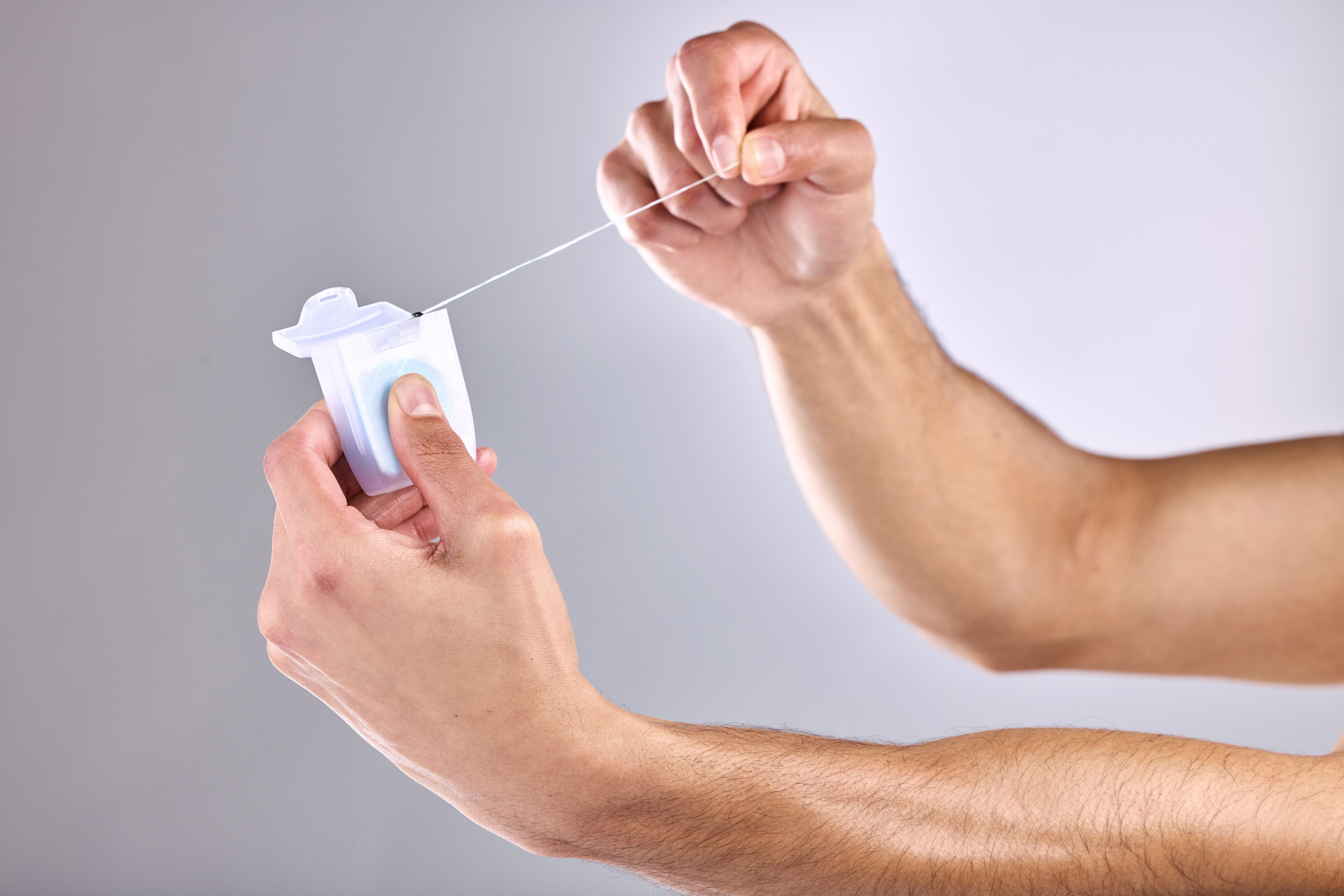If you’ve ever flossed and noticed your gums bleeding, you might have felt concerned or even discouraged. However, bleeding gums during flossing is a common issue, and it’s often a sign that your gums need more attention, not less. Many people wonder if flossing regularly can actually stop gums from bleeding and improve overall oral health.
In this article, we’ll dive into the topic of bleeding gums, how flossing can help, and what you can do to improve your gum health. We’ll cover important questions like, “Can you floss away gingivitis?” and “How long does it take for bleeding gums to heal after you start flossing?”
Why Do Gums Bleed When Flossing?
Bleeding gums during flossing is a sign that your gums are inflamed. Inflammation occurs when plaque, a sticky film of bacteria, builds up along the gumline and between your teeth. If plaque isn’t removed through proper brushing and flossing, it can harden into tartar, which further irritates your gums and leads to gingivitis, the earliest stage of gum disease.

Here are some common reasons your gums may bleed when you floss:
- Gingivitis: This is the most common cause of bleeding gums. It’s caused by plaque buildup along the gumline, which leads to redness, swelling, and bleeding when you floss or brush.
- Not Flossing Regularly: If you haven’t been flossing consistently, your gums may become more sensitive and prone to bleeding. Plaque can build up quickly in the spaces between your teeth, causing irritation.
- Flossing Too Aggressively: Sometimes, bleeding gums are caused by flossing too roughly. While flossing is essential, it’s important to be gentle and avoid snapping the floss into your gums.
- Hormonal Changes: Pregnancy, menopause, or other hormonal changes can make your gums more sensitive and more likely to bleed during flossing.
- Medications: Some medications, like blood thinners, can increase the likelihood of gum bleeding.
If your gums are bleeding, it’s important not to stop flossing. In fact, continuing to floss correctly can help reduce gum inflammation over time and improve your gum health.
Can You Floss Away Gingivitis?
The good news is that gingivitis is reversible with proper oral care, and regular flossing plays a key role in reversing it. Gingivitis occurs when plaque irritates your gums, causing them to swell and bleed. However, by brushing twice a day, flossing daily, and visiting your dentist for regular cleanings, you can remove the plaque and allow your gums to heal.\

Flossing helps remove plaque and food particles from between your teeth and along the gumline—places your toothbrush can’t always reach. When you floss every day, you’re helping to reduce the bacteria that cause gingivitis, which in turn can reduce gum inflammation and bleeding.
It’s important to note that gingivitis doesn’t go away overnight. It may take a few weeks of consistent brushing and flossing for your gums to heal and stop bleeding. However, with persistence, you can floss away gingivitis and restore your gum health.
Will My Gums Stop Bleeding if I Start Flossing?
Yes, your gums will likely stop bleeding if you start flossing regularly. In most cases, bleeding gums are a sign that you’re not flossing enough or that there’s plaque buildup irritating your gums. Once you begin flossing every day, you’ll help remove the plaque and bacteria that are causing the inflammation.
It’s important to give your gums time to adjust. Initially, your gums may bleed more when you start flossing regularly, especially if you haven’t flossed in a while. However, as your gums become healthier and less inflamed, the bleeding should gradually subside.
To help stop your gums from bleeding:
- Floss daily: Be consistent with flossing every day. This helps keep plaque from building up and irritating your gums.
- Use the right technique: Be gentle when flossing. Guide the floss between your teeth, curve it around the base of each tooth, and move it up and down to remove plaque.
- Don’t give up: If your gums bleed, it can be tempting to stop flossing, but that will only allow plaque to build up and make the problem worse. Keep flossing, and your gums should improve over time.
If your gums continue to bleed after a few weeks of regular flossing, it’s a good idea to see a dentist. There may be other underlying issues, such as advanced gum disease or other health conditions, that need to be addressed.
How Long Do I Have to Floss Before It Stops Hurting?
If your gums are sore or bleeding when you first start flossing, the discomfort should go away within a week or two of regular flossing. The key is consistency. When you floss every day, your gums will become healthier, and the sensitivity should decrease over time.
In the beginning, your gums may feel tender, especially if you’re not used to flossing. This tenderness is due to inflammation, which is caused by plaque and bacteria irritating your gums. As you continue to floss and remove the plaque, your gums will heal, and the soreness should fade.
Here are some tips to make flossing more comfortable while your gums adjust:
- Be gentle: Don’t force the floss between your teeth or snap it into your gums. Instead, gently slide the floss between your teeth and curve it around the base of each tooth.
- Use a soft floss: If traditional floss feels uncomfortable, try using a softer, more flexible floss or a floss pick designed for sensitive gums.
- Try a water flosser: If regular flossing is too painful, a water flosser can be a gentler option for cleaning between your teeth. It uses a stream of water to remove plaque and debris without putting pressure on your gums.
With regular care, your gums will heal, and flossing will become a more comfortable and painless part of your oral hygiene routine.
How Long Does It Take for Flossing to Make a Difference?
You should start noticing a difference in your gum health within a few days to a week of regular flossing. However, it may take a few weeks to see more significant improvements, especially if you’re dealing with gingivitis or more severe gum inflammation.

Here’s what to expect as you begin flossing regularly:
- After a few days: Your gums may still bleed, but you’ll start to remove plaque and debris from between your teeth, reducing the bacteria that cause gum inflammation.
- After one week: You should start noticing less gum bleeding and reduced tenderness as your gums begin to heal from regular flossing.
- After two to three weeks: If you’re consistent with flossing and brushing, your gums should be significantly healthier, with less bleeding, swelling, and discomfort.
Remember that every person’s oral health is different, so the time it takes for your gums to stop bleeding and become healthier may vary. However, with dedication to daily flossing and proper oral hygiene, you’ll start to see improvements in a few weeks.
Can Flossing Prevent Gum Disease?
Yes, flossing is one of the best ways to prevent gum disease. Gum disease, also known as periodontal disease, is caused by a buildup of plaque and bacteria along the gumline. If left untreated, it can progress from gingivitis (early gum disease) to more serious forms of periodontal disease, which can lead to tooth loss.
Flossing helps remove the plaque and food particles that your toothbrush can’t reach, especially in the tight spaces between your teeth. By flossing daily, you’re helping to keep your gums healthy and preventing the bacteria from causing inflammation and gum disease.
In addition to flossing, here are other ways to prevent gum disease:
- Brush your teeth twice a day: Use a soft-bristled toothbrush and fluoride toothpaste to clean your teeth and gums.
- Visit your dentist regularly: Get professional cleanings every six months to remove tartar and detect any early signs of gum disease.
- Use mouthwash: An antibacterial mouthwash can help kill bacteria and reduce plaque in your mouth.
- Maintain a healthy diet: Eating a balanced diet that’s low in sugary foods and drinks can help protect your teeth and gums from decay and disease.
By making flossing a daily habit, you can significantly reduce your risk of developing gum disease and keep your gums healthy for years to come.
Conclusion: Flossing Can Stop Bleeding Gums and Improve Your Oral Health
If your gums bleed when you floss, it’s a sign that they need more care, not less. Flossing is one of the most effective ways to remove plaque and bacteria from between your teeth, which can help reduce gum inflammation and stop bleeding.
With regular flossing, you can reverse early signs of gingivitis, prevent gum disease, and keep your gums healthy. Remember to floss gently and consistently, and give your gums time to adjust and heal. If you stick with it, you’ll soon notice healthier gums that don’t bleed or hurt when you floss.
Incorporating daily flossing into your oral hygiene routine is a simple but powerful way to maintain good gum health and prevent serious dental problems down the road.


